University Investment Management Module: Portfolio Analysis Report
VerifiedAdded on 2022/08/31
|10
|2156
|25
Report
AI Summary
This report provides a comprehensive analysis of investment strategies and portfolio management, tailored for potential investors seeking a sustainable and actively managed approach. It delves into the core concepts of investment analysis, emphasizing the importance of risk assessment and diversification. The report examines various investment options, including stocks, bonds, and commodities, and suggests an investment strategy that balances risk and return. The author proposes an allocation of funds across different asset classes, considering current market trends and economic indicators. Key aspects include the identification of 'hot' sectors, technological developments, and potential trading strategies, culminating in a unique selling proposition for the investment management approach. The report stresses the importance of a diversified portfolio, incorporating both risky and risk-free assets, and the need for a long-term perspective in investment decision-making.
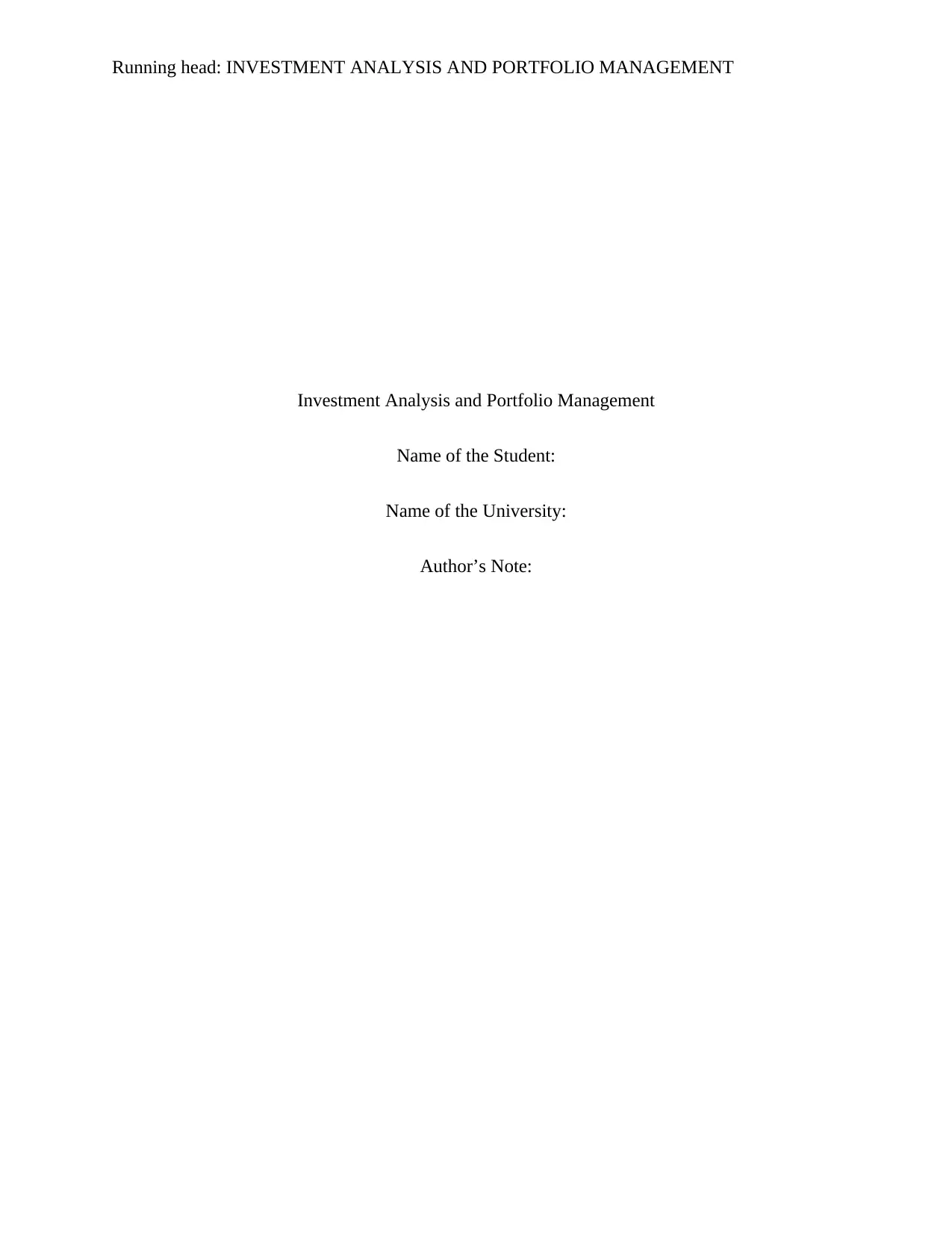
Running head: INVESTMENT ANALYSIS AND PORTFOLIO MANAGEMENT
Investment Analysis and Portfolio Management
Name of the Student:
Name of the University:
Author’s Note:
Investment Analysis and Portfolio Management
Name of the Student:
Name of the University:
Author’s Note:
Paraphrase This Document
Need a fresh take? Get an instant paraphrase of this document with our AI Paraphraser
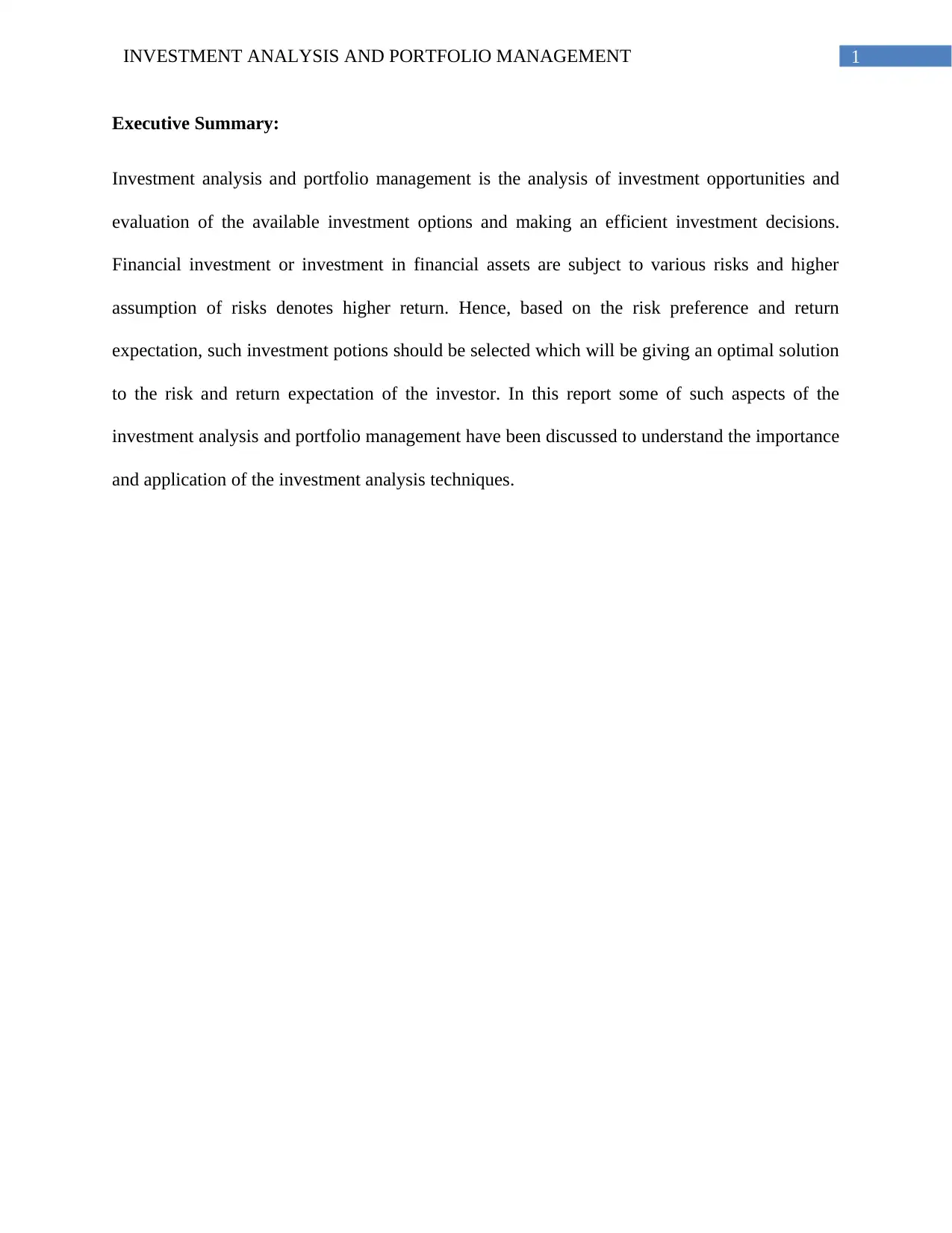
1INVESTMENT ANALYSIS AND PORTFOLIO MANAGEMENT
Executive Summary:
Investment analysis and portfolio management is the analysis of investment opportunities and
evaluation of the available investment options and making an efficient investment decisions.
Financial investment or investment in financial assets are subject to various risks and higher
assumption of risks denotes higher return. Hence, based on the risk preference and return
expectation, such investment potions should be selected which will be giving an optimal solution
to the risk and return expectation of the investor. In this report some of such aspects of the
investment analysis and portfolio management have been discussed to understand the importance
and application of the investment analysis techniques.
Executive Summary:
Investment analysis and portfolio management is the analysis of investment opportunities and
evaluation of the available investment options and making an efficient investment decisions.
Financial investment or investment in financial assets are subject to various risks and higher
assumption of risks denotes higher return. Hence, based on the risk preference and return
expectation, such investment potions should be selected which will be giving an optimal solution
to the risk and return expectation of the investor. In this report some of such aspects of the
investment analysis and portfolio management have been discussed to understand the importance
and application of the investment analysis techniques.
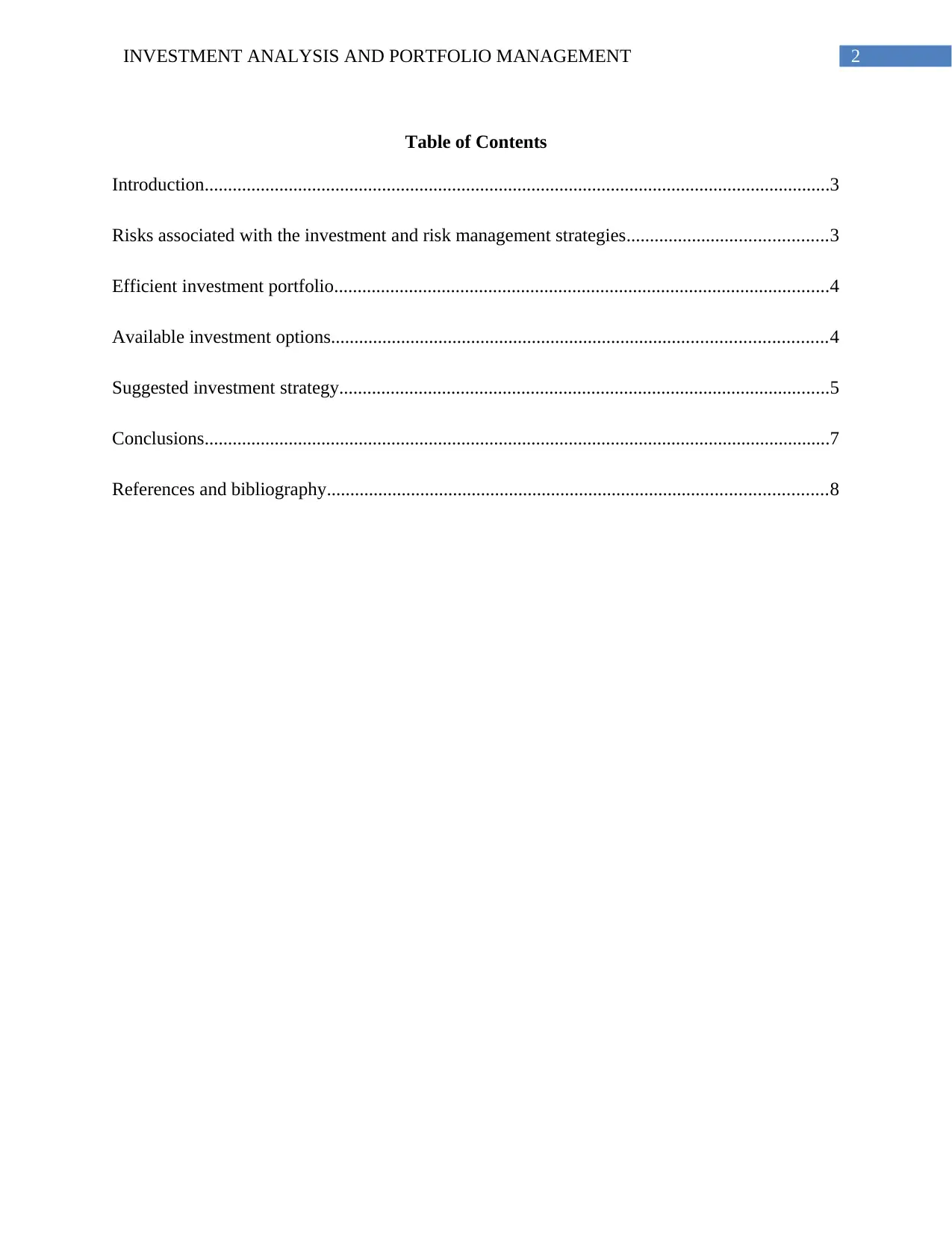
2INVESTMENT ANALYSIS AND PORTFOLIO MANAGEMENT
Table of Contents
Introduction......................................................................................................................................3
Risks associated with the investment and risk management strategies...........................................3
Efficient investment portfolio..........................................................................................................4
Available investment options..........................................................................................................4
Suggested investment strategy.........................................................................................................5
Conclusions......................................................................................................................................7
References and bibliography...........................................................................................................8
Table of Contents
Introduction......................................................................................................................................3
Risks associated with the investment and risk management strategies...........................................3
Efficient investment portfolio..........................................................................................................4
Available investment options..........................................................................................................4
Suggested investment strategy.........................................................................................................5
Conclusions......................................................................................................................................7
References and bibliography...........................................................................................................8
⊘ This is a preview!⊘
Do you want full access?
Subscribe today to unlock all pages.

Trusted by 1+ million students worldwide
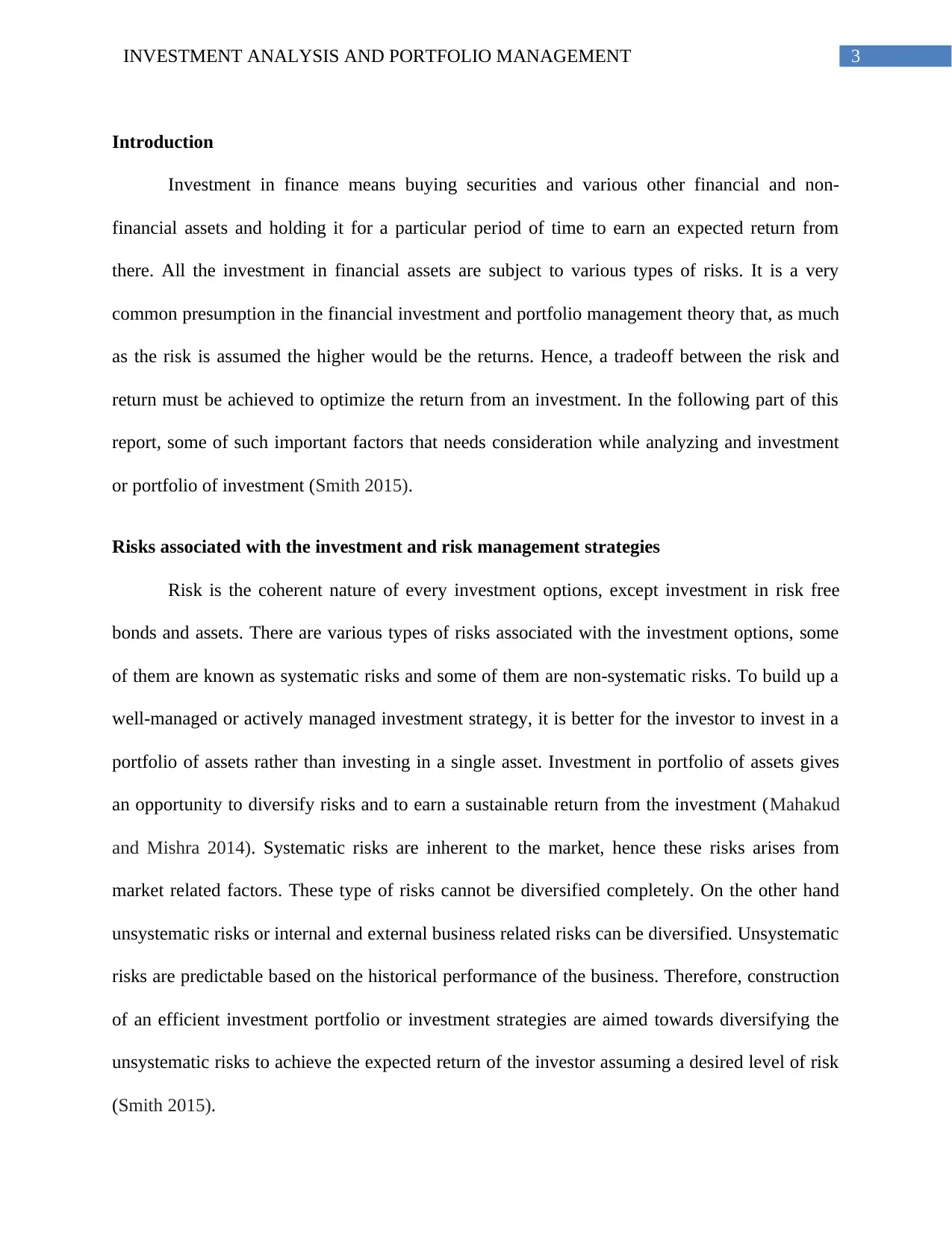
3INVESTMENT ANALYSIS AND PORTFOLIO MANAGEMENT
Introduction
Investment in finance means buying securities and various other financial and non-
financial assets and holding it for a particular period of time to earn an expected return from
there. All the investment in financial assets are subject to various types of risks. It is a very
common presumption in the financial investment and portfolio management theory that, as much
as the risk is assumed the higher would be the returns. Hence, a tradeoff between the risk and
return must be achieved to optimize the return from an investment. In the following part of this
report, some of such important factors that needs consideration while analyzing and investment
or portfolio of investment (Smith 2015).
Risks associated with the investment and risk management strategies
Risk is the coherent nature of every investment options, except investment in risk free
bonds and assets. There are various types of risks associated with the investment options, some
of them are known as systematic risks and some of them are non-systematic risks. To build up a
well-managed or actively managed investment strategy, it is better for the investor to invest in a
portfolio of assets rather than investing in a single asset. Investment in portfolio of assets gives
an opportunity to diversify risks and to earn a sustainable return from the investment (Mahakud
and Mishra 2014). Systematic risks are inherent to the market, hence these risks arises from
market related factors. These type of risks cannot be diversified completely. On the other hand
unsystematic risks or internal and external business related risks can be diversified. Unsystematic
risks are predictable based on the historical performance of the business. Therefore, construction
of an efficient investment portfolio or investment strategies are aimed towards diversifying the
unsystematic risks to achieve the expected return of the investor assuming a desired level of risk
(Smith 2015).
Introduction
Investment in finance means buying securities and various other financial and non-
financial assets and holding it for a particular period of time to earn an expected return from
there. All the investment in financial assets are subject to various types of risks. It is a very
common presumption in the financial investment and portfolio management theory that, as much
as the risk is assumed the higher would be the returns. Hence, a tradeoff between the risk and
return must be achieved to optimize the return from an investment. In the following part of this
report, some of such important factors that needs consideration while analyzing and investment
or portfolio of investment (Smith 2015).
Risks associated with the investment and risk management strategies
Risk is the coherent nature of every investment options, except investment in risk free
bonds and assets. There are various types of risks associated with the investment options, some
of them are known as systematic risks and some of them are non-systematic risks. To build up a
well-managed or actively managed investment strategy, it is better for the investor to invest in a
portfolio of assets rather than investing in a single asset. Investment in portfolio of assets gives
an opportunity to diversify risks and to earn a sustainable return from the investment (Mahakud
and Mishra 2014). Systematic risks are inherent to the market, hence these risks arises from
market related factors. These type of risks cannot be diversified completely. On the other hand
unsystematic risks or internal and external business related risks can be diversified. Unsystematic
risks are predictable based on the historical performance of the business. Therefore, construction
of an efficient investment portfolio or investment strategies are aimed towards diversifying the
unsystematic risks to achieve the expected return of the investor assuming a desired level of risk
(Smith 2015).
Paraphrase This Document
Need a fresh take? Get an instant paraphrase of this document with our AI Paraphraser
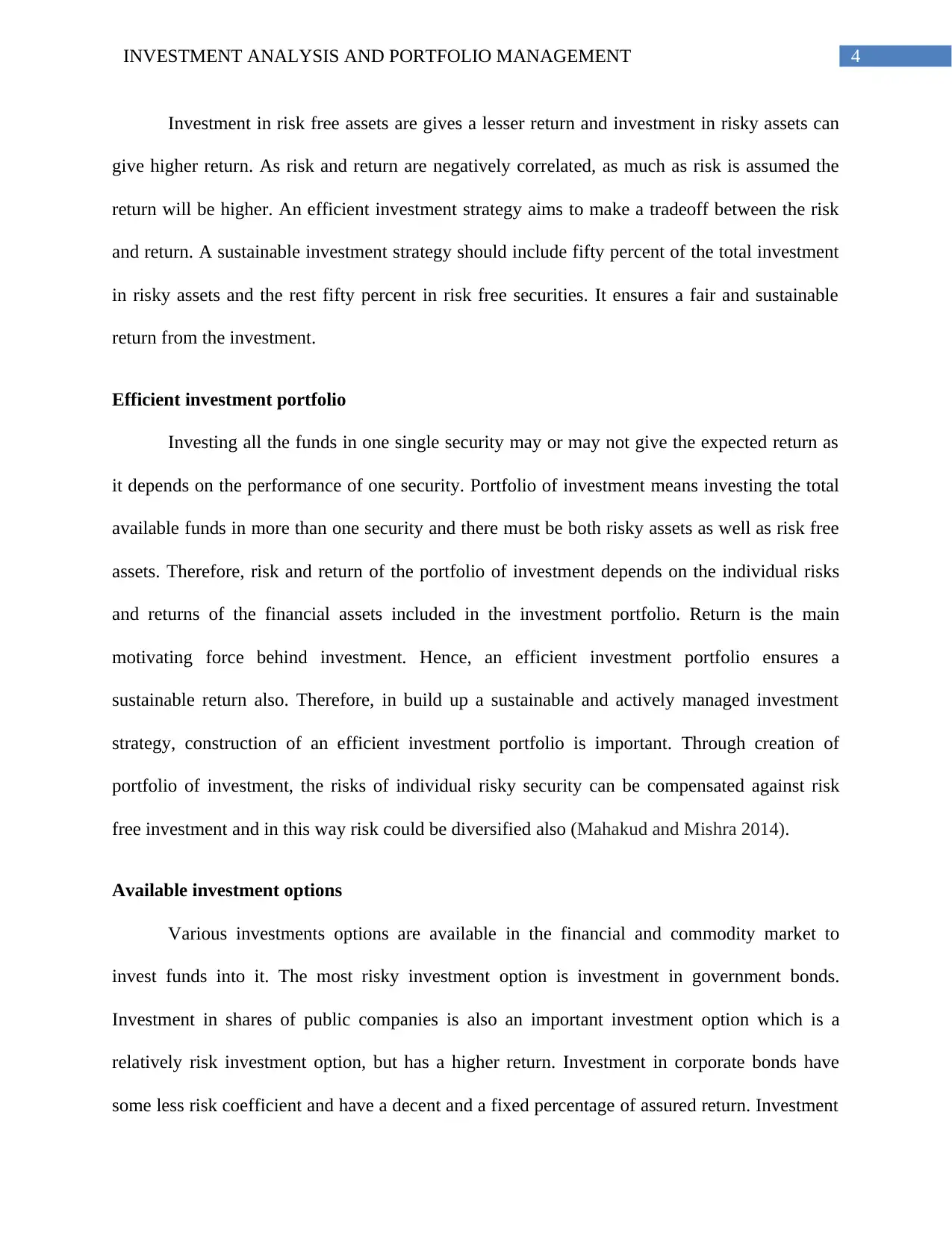
4INVESTMENT ANALYSIS AND PORTFOLIO MANAGEMENT
Investment in risk free assets are gives a lesser return and investment in risky assets can
give higher return. As risk and return are negatively correlated, as much as risk is assumed the
return will be higher. An efficient investment strategy aims to make a tradeoff between the risk
and return. A sustainable investment strategy should include fifty percent of the total investment
in risky assets and the rest fifty percent in risk free securities. It ensures a fair and sustainable
return from the investment.
Efficient investment portfolio
Investing all the funds in one single security may or may not give the expected return as
it depends on the performance of one security. Portfolio of investment means investing the total
available funds in more than one security and there must be both risky assets as well as risk free
assets. Therefore, risk and return of the portfolio of investment depends on the individual risks
and returns of the financial assets included in the investment portfolio. Return is the main
motivating force behind investment. Hence, an efficient investment portfolio ensures a
sustainable return also. Therefore, in build up a sustainable and actively managed investment
strategy, construction of an efficient investment portfolio is important. Through creation of
portfolio of investment, the risks of individual risky security can be compensated against risk
free investment and in this way risk could be diversified also (Mahakud and Mishra 2014).
Available investment options
Various investments options are available in the financial and commodity market to
invest funds into it. The most risky investment option is investment in government bonds.
Investment in shares of public companies is also an important investment option which is a
relatively risk investment option, but has a higher return. Investment in corporate bonds have
some less risk coefficient and have a decent and a fixed percentage of assured return. Investment
Investment in risk free assets are gives a lesser return and investment in risky assets can
give higher return. As risk and return are negatively correlated, as much as risk is assumed the
return will be higher. An efficient investment strategy aims to make a tradeoff between the risk
and return. A sustainable investment strategy should include fifty percent of the total investment
in risky assets and the rest fifty percent in risk free securities. It ensures a fair and sustainable
return from the investment.
Efficient investment portfolio
Investing all the funds in one single security may or may not give the expected return as
it depends on the performance of one security. Portfolio of investment means investing the total
available funds in more than one security and there must be both risky assets as well as risk free
assets. Therefore, risk and return of the portfolio of investment depends on the individual risks
and returns of the financial assets included in the investment portfolio. Return is the main
motivating force behind investment. Hence, an efficient investment portfolio ensures a
sustainable return also. Therefore, in build up a sustainable and actively managed investment
strategy, construction of an efficient investment portfolio is important. Through creation of
portfolio of investment, the risks of individual risky security can be compensated against risk
free investment and in this way risk could be diversified also (Mahakud and Mishra 2014).
Available investment options
Various investments options are available in the financial and commodity market to
invest funds into it. The most risky investment option is investment in government bonds.
Investment in shares of public companies is also an important investment option which is a
relatively risk investment option, but has a higher return. Investment in corporate bonds have
some less risk coefficient and have a decent and a fixed percentage of assured return. Investment
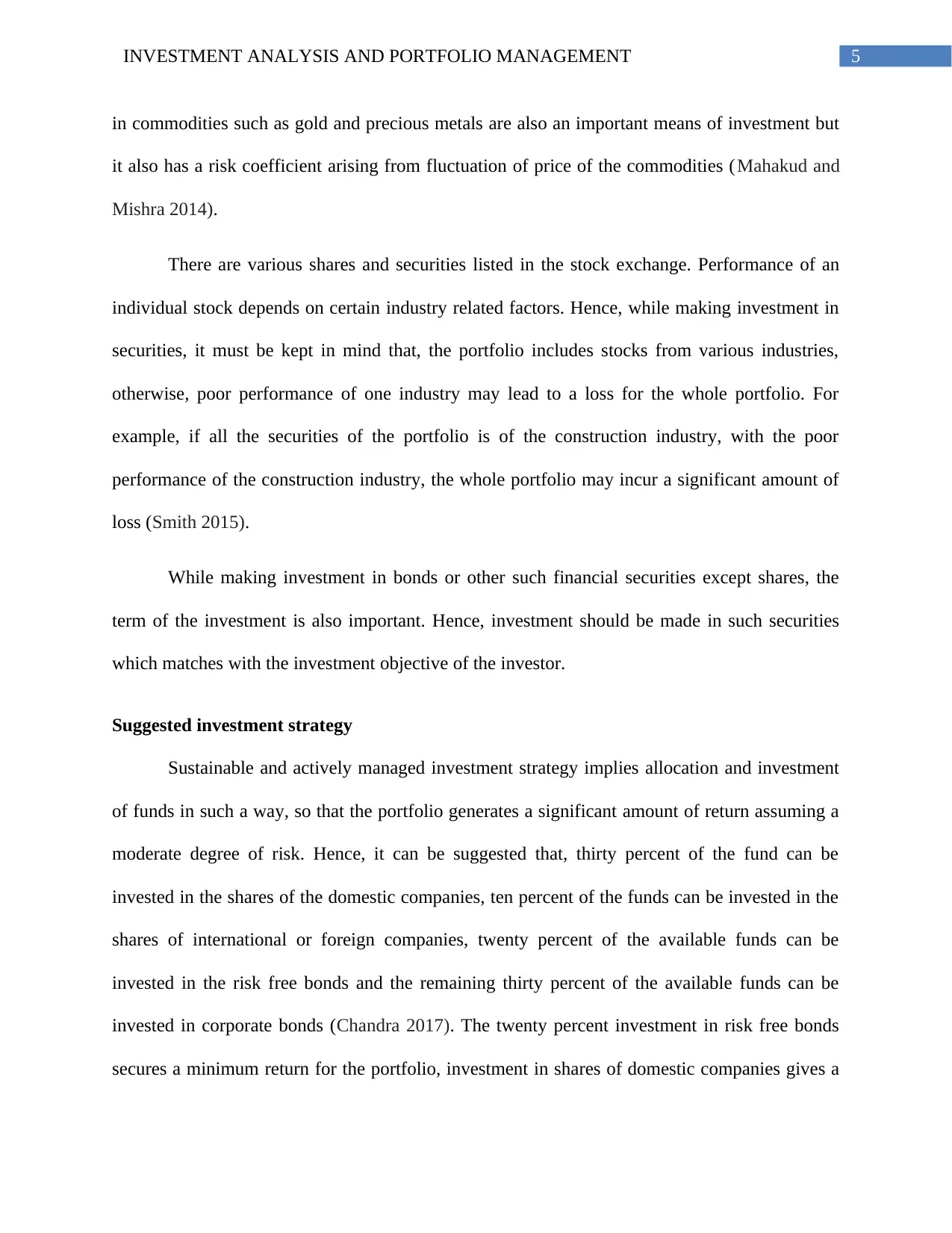
5INVESTMENT ANALYSIS AND PORTFOLIO MANAGEMENT
in commodities such as gold and precious metals are also an important means of investment but
it also has a risk coefficient arising from fluctuation of price of the commodities (Mahakud and
Mishra 2014).
There are various shares and securities listed in the stock exchange. Performance of an
individual stock depends on certain industry related factors. Hence, while making investment in
securities, it must be kept in mind that, the portfolio includes stocks from various industries,
otherwise, poor performance of one industry may lead to a loss for the whole portfolio. For
example, if all the securities of the portfolio is of the construction industry, with the poor
performance of the construction industry, the whole portfolio may incur a significant amount of
loss (Smith 2015).
While making investment in bonds or other such financial securities except shares, the
term of the investment is also important. Hence, investment should be made in such securities
which matches with the investment objective of the investor.
Suggested investment strategy
Sustainable and actively managed investment strategy implies allocation and investment
of funds in such a way, so that the portfolio generates a significant amount of return assuming a
moderate degree of risk. Hence, it can be suggested that, thirty percent of the fund can be
invested in the shares of the domestic companies, ten percent of the funds can be invested in the
shares of international or foreign companies, twenty percent of the available funds can be
invested in the risk free bonds and the remaining thirty percent of the available funds can be
invested in corporate bonds (Chandra 2017). The twenty percent investment in risk free bonds
secures a minimum return for the portfolio, investment in shares of domestic companies gives a
in commodities such as gold and precious metals are also an important means of investment but
it also has a risk coefficient arising from fluctuation of price of the commodities (Mahakud and
Mishra 2014).
There are various shares and securities listed in the stock exchange. Performance of an
individual stock depends on certain industry related factors. Hence, while making investment in
securities, it must be kept in mind that, the portfolio includes stocks from various industries,
otherwise, poor performance of one industry may lead to a loss for the whole portfolio. For
example, if all the securities of the portfolio is of the construction industry, with the poor
performance of the construction industry, the whole portfolio may incur a significant amount of
loss (Smith 2015).
While making investment in bonds or other such financial securities except shares, the
term of the investment is also important. Hence, investment should be made in such securities
which matches with the investment objective of the investor.
Suggested investment strategy
Sustainable and actively managed investment strategy implies allocation and investment
of funds in such a way, so that the portfolio generates a significant amount of return assuming a
moderate degree of risk. Hence, it can be suggested that, thirty percent of the fund can be
invested in the shares of the domestic companies, ten percent of the funds can be invested in the
shares of international or foreign companies, twenty percent of the available funds can be
invested in the risk free bonds and the remaining thirty percent of the available funds can be
invested in corporate bonds (Chandra 2017). The twenty percent investment in risk free bonds
secures a minimum return for the portfolio, investment in shares of domestic companies gives a
⊘ This is a preview!⊘
Do you want full access?
Subscribe today to unlock all pages.

Trusted by 1+ million students worldwide
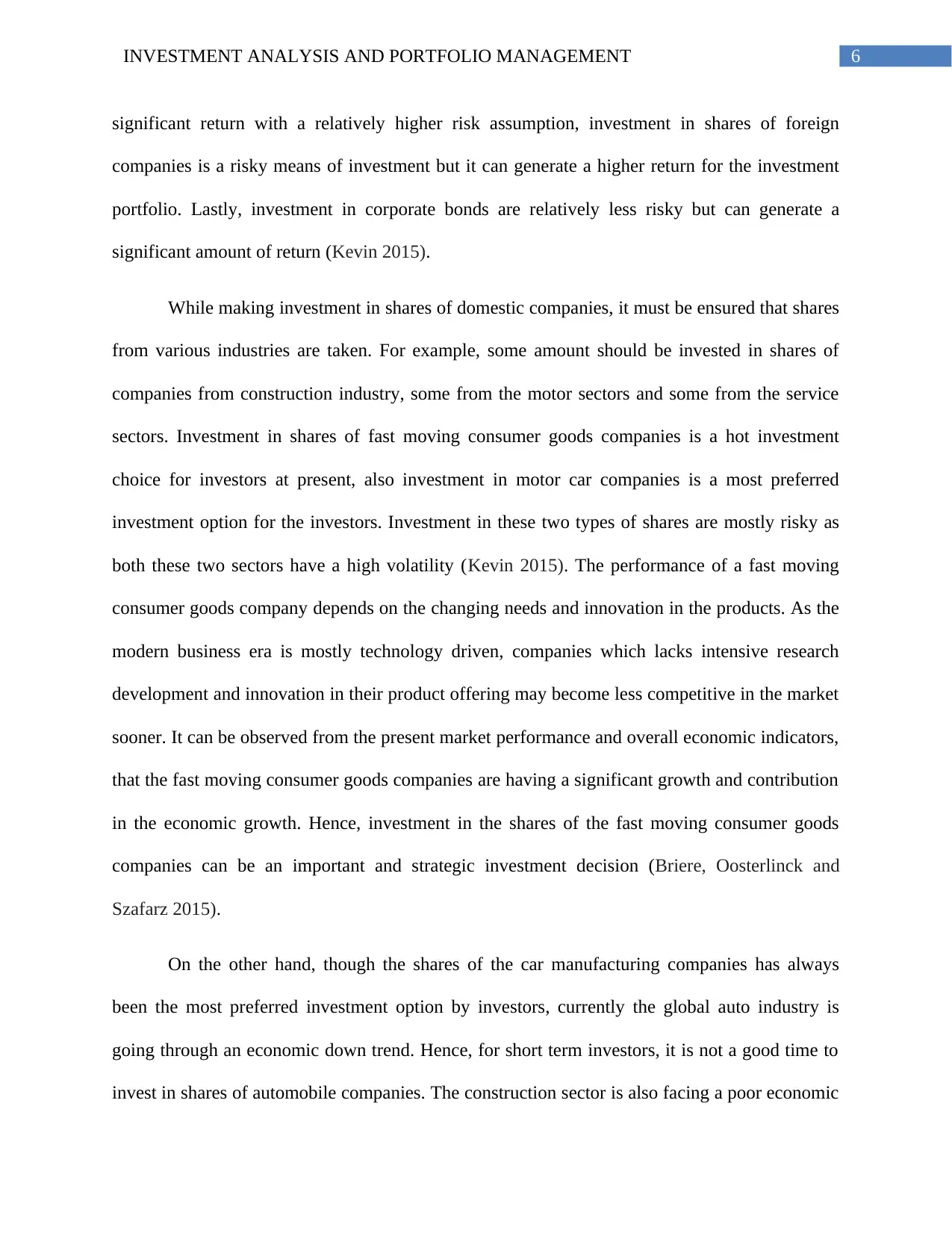
6INVESTMENT ANALYSIS AND PORTFOLIO MANAGEMENT
significant return with a relatively higher risk assumption, investment in shares of foreign
companies is a risky means of investment but it can generate a higher return for the investment
portfolio. Lastly, investment in corporate bonds are relatively less risky but can generate a
significant amount of return (Kevin 2015).
While making investment in shares of domestic companies, it must be ensured that shares
from various industries are taken. For example, some amount should be invested in shares of
companies from construction industry, some from the motor sectors and some from the service
sectors. Investment in shares of fast moving consumer goods companies is a hot investment
choice for investors at present, also investment in motor car companies is a most preferred
investment option for the investors. Investment in these two types of shares are mostly risky as
both these two sectors have a high volatility (Kevin 2015). The performance of a fast moving
consumer goods company depends on the changing needs and innovation in the products. As the
modern business era is mostly technology driven, companies which lacks intensive research
development and innovation in their product offering may become less competitive in the market
sooner. It can be observed from the present market performance and overall economic indicators,
that the fast moving consumer goods companies are having a significant growth and contribution
in the economic growth. Hence, investment in the shares of the fast moving consumer goods
companies can be an important and strategic investment decision (Briere, Oosterlinck and
Szafarz 2015).
On the other hand, though the shares of the car manufacturing companies has always
been the most preferred investment option by investors, currently the global auto industry is
going through an economic down trend. Hence, for short term investors, it is not a good time to
invest in shares of automobile companies. The construction sector is also facing a poor economic
significant return with a relatively higher risk assumption, investment in shares of foreign
companies is a risky means of investment but it can generate a higher return for the investment
portfolio. Lastly, investment in corporate bonds are relatively less risky but can generate a
significant amount of return (Kevin 2015).
While making investment in shares of domestic companies, it must be ensured that shares
from various industries are taken. For example, some amount should be invested in shares of
companies from construction industry, some from the motor sectors and some from the service
sectors. Investment in shares of fast moving consumer goods companies is a hot investment
choice for investors at present, also investment in motor car companies is a most preferred
investment option for the investors. Investment in these two types of shares are mostly risky as
both these two sectors have a high volatility (Kevin 2015). The performance of a fast moving
consumer goods company depends on the changing needs and innovation in the products. As the
modern business era is mostly technology driven, companies which lacks intensive research
development and innovation in their product offering may become less competitive in the market
sooner. It can be observed from the present market performance and overall economic indicators,
that the fast moving consumer goods companies are having a significant growth and contribution
in the economic growth. Hence, investment in the shares of the fast moving consumer goods
companies can be an important and strategic investment decision (Briere, Oosterlinck and
Szafarz 2015).
On the other hand, though the shares of the car manufacturing companies has always
been the most preferred investment option by investors, currently the global auto industry is
going through an economic down trend. Hence, for short term investors, it is not a good time to
invest in shares of automobile companies. The construction sector is also facing a poor economic
Paraphrase This Document
Need a fresh take? Get an instant paraphrase of this document with our AI Paraphraser
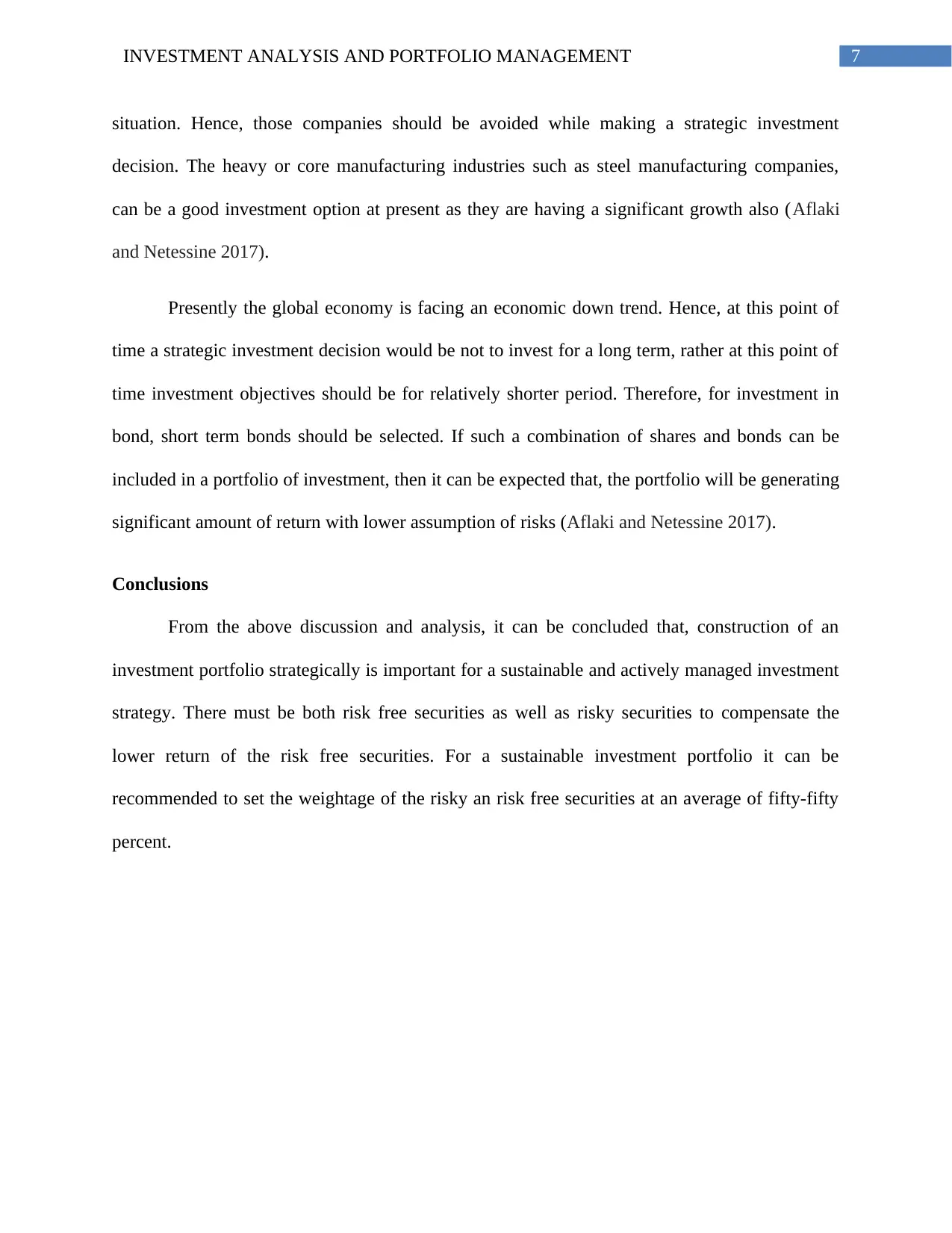
7INVESTMENT ANALYSIS AND PORTFOLIO MANAGEMENT
situation. Hence, those companies should be avoided while making a strategic investment
decision. The heavy or core manufacturing industries such as steel manufacturing companies,
can be a good investment option at present as they are having a significant growth also (Aflaki
and Netessine 2017).
Presently the global economy is facing an economic down trend. Hence, at this point of
time a strategic investment decision would be not to invest for a long term, rather at this point of
time investment objectives should be for relatively shorter period. Therefore, for investment in
bond, short term bonds should be selected. If such a combination of shares and bonds can be
included in a portfolio of investment, then it can be expected that, the portfolio will be generating
significant amount of return with lower assumption of risks (Aflaki and Netessine 2017).
Conclusions
From the above discussion and analysis, it can be concluded that, construction of an
investment portfolio strategically is important for a sustainable and actively managed investment
strategy. There must be both risk free securities as well as risky securities to compensate the
lower return of the risk free securities. For a sustainable investment portfolio it can be
recommended to set the weightage of the risky an risk free securities at an average of fifty-fifty
percent.
situation. Hence, those companies should be avoided while making a strategic investment
decision. The heavy or core manufacturing industries such as steel manufacturing companies,
can be a good investment option at present as they are having a significant growth also (Aflaki
and Netessine 2017).
Presently the global economy is facing an economic down trend. Hence, at this point of
time a strategic investment decision would be not to invest for a long term, rather at this point of
time investment objectives should be for relatively shorter period. Therefore, for investment in
bond, short term bonds should be selected. If such a combination of shares and bonds can be
included in a portfolio of investment, then it can be expected that, the portfolio will be generating
significant amount of return with lower assumption of risks (Aflaki and Netessine 2017).
Conclusions
From the above discussion and analysis, it can be concluded that, construction of an
investment portfolio strategically is important for a sustainable and actively managed investment
strategy. There must be both risk free securities as well as risky securities to compensate the
lower return of the risk free securities. For a sustainable investment portfolio it can be
recommended to set the weightage of the risky an risk free securities at an average of fifty-fifty
percent.
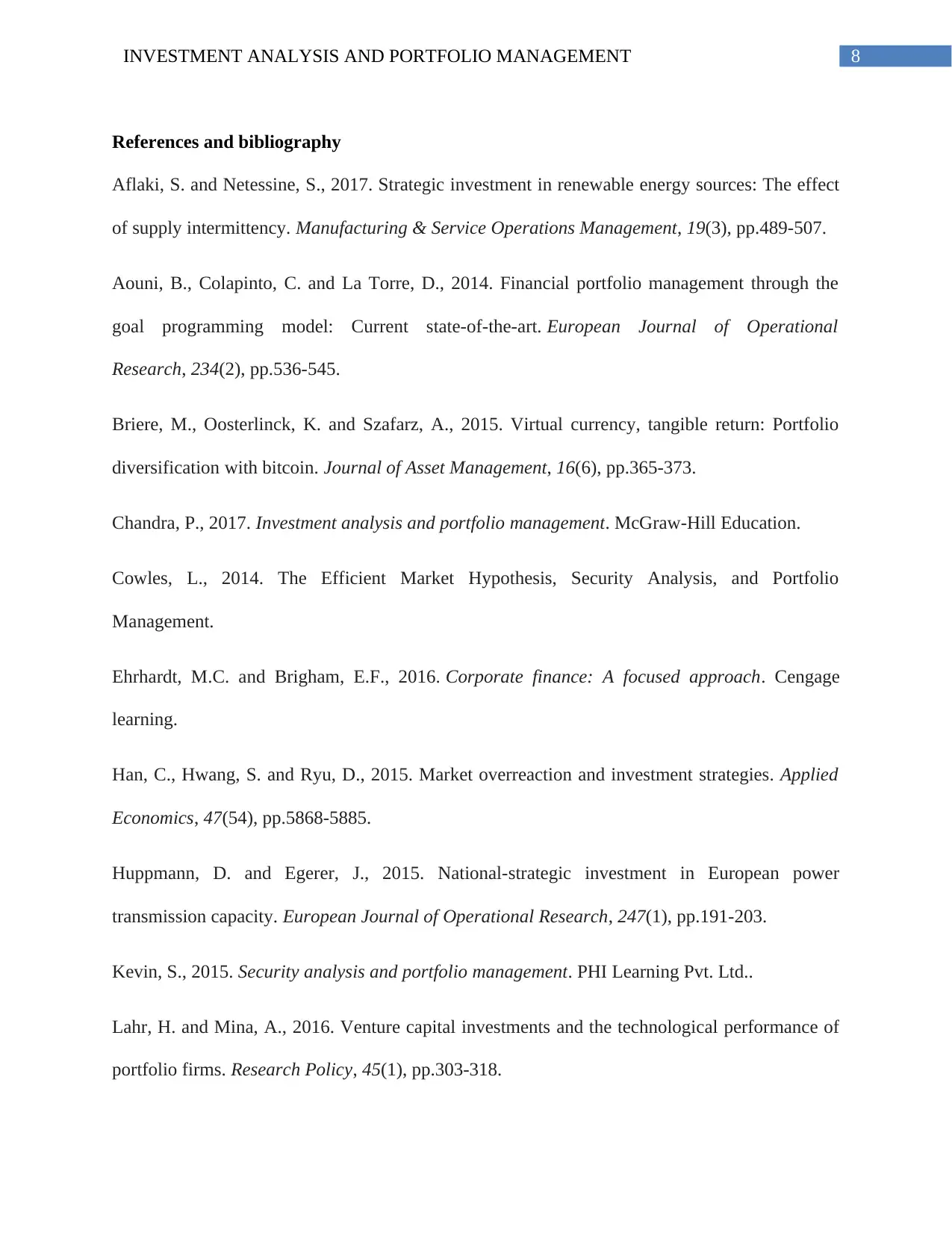
8INVESTMENT ANALYSIS AND PORTFOLIO MANAGEMENT
References and bibliography
Aflaki, S. and Netessine, S., 2017. Strategic investment in renewable energy sources: The effect
of supply intermittency. Manufacturing & Service Operations Management, 19(3), pp.489-507.
Aouni, B., Colapinto, C. and La Torre, D., 2014. Financial portfolio management through the
goal programming model: Current state-of-the-art. European Journal of Operational
Research, 234(2), pp.536-545.
Briere, M., Oosterlinck, K. and Szafarz, A., 2015. Virtual currency, tangible return: Portfolio
diversification with bitcoin. Journal of Asset Management, 16(6), pp.365-373.
Chandra, P., 2017. Investment analysis and portfolio management. McGraw-Hill Education.
Cowles, L., 2014. The Efficient Market Hypothesis, Security Analysis, and Portfolio
Management.
Ehrhardt, M.C. and Brigham, E.F., 2016. Corporate finance: A focused approach. Cengage
learning.
Han, C., Hwang, S. and Ryu, D., 2015. Market overreaction and investment strategies. Applied
Economics, 47(54), pp.5868-5885.
Huppmann, D. and Egerer, J., 2015. National-strategic investment in European power
transmission capacity. European Journal of Operational Research, 247(1), pp.191-203.
Kevin, S., 2015. Security analysis and portfolio management. PHI Learning Pvt. Ltd..
Lahr, H. and Mina, A., 2016. Venture capital investments and the technological performance of
portfolio firms. Research Policy, 45(1), pp.303-318.
References and bibliography
Aflaki, S. and Netessine, S., 2017. Strategic investment in renewable energy sources: The effect
of supply intermittency. Manufacturing & Service Operations Management, 19(3), pp.489-507.
Aouni, B., Colapinto, C. and La Torre, D., 2014. Financial portfolio management through the
goal programming model: Current state-of-the-art. European Journal of Operational
Research, 234(2), pp.536-545.
Briere, M., Oosterlinck, K. and Szafarz, A., 2015. Virtual currency, tangible return: Portfolio
diversification with bitcoin. Journal of Asset Management, 16(6), pp.365-373.
Chandra, P., 2017. Investment analysis and portfolio management. McGraw-Hill Education.
Cowles, L., 2014. The Efficient Market Hypothesis, Security Analysis, and Portfolio
Management.
Ehrhardt, M.C. and Brigham, E.F., 2016. Corporate finance: A focused approach. Cengage
learning.
Han, C., Hwang, S. and Ryu, D., 2015. Market overreaction and investment strategies. Applied
Economics, 47(54), pp.5868-5885.
Huppmann, D. and Egerer, J., 2015. National-strategic investment in European power
transmission capacity. European Journal of Operational Research, 247(1), pp.191-203.
Kevin, S., 2015. Security analysis and portfolio management. PHI Learning Pvt. Ltd..
Lahr, H. and Mina, A., 2016. Venture capital investments and the technological performance of
portfolio firms. Research Policy, 45(1), pp.303-318.
⊘ This is a preview!⊘
Do you want full access?
Subscribe today to unlock all pages.

Trusted by 1+ million students worldwide
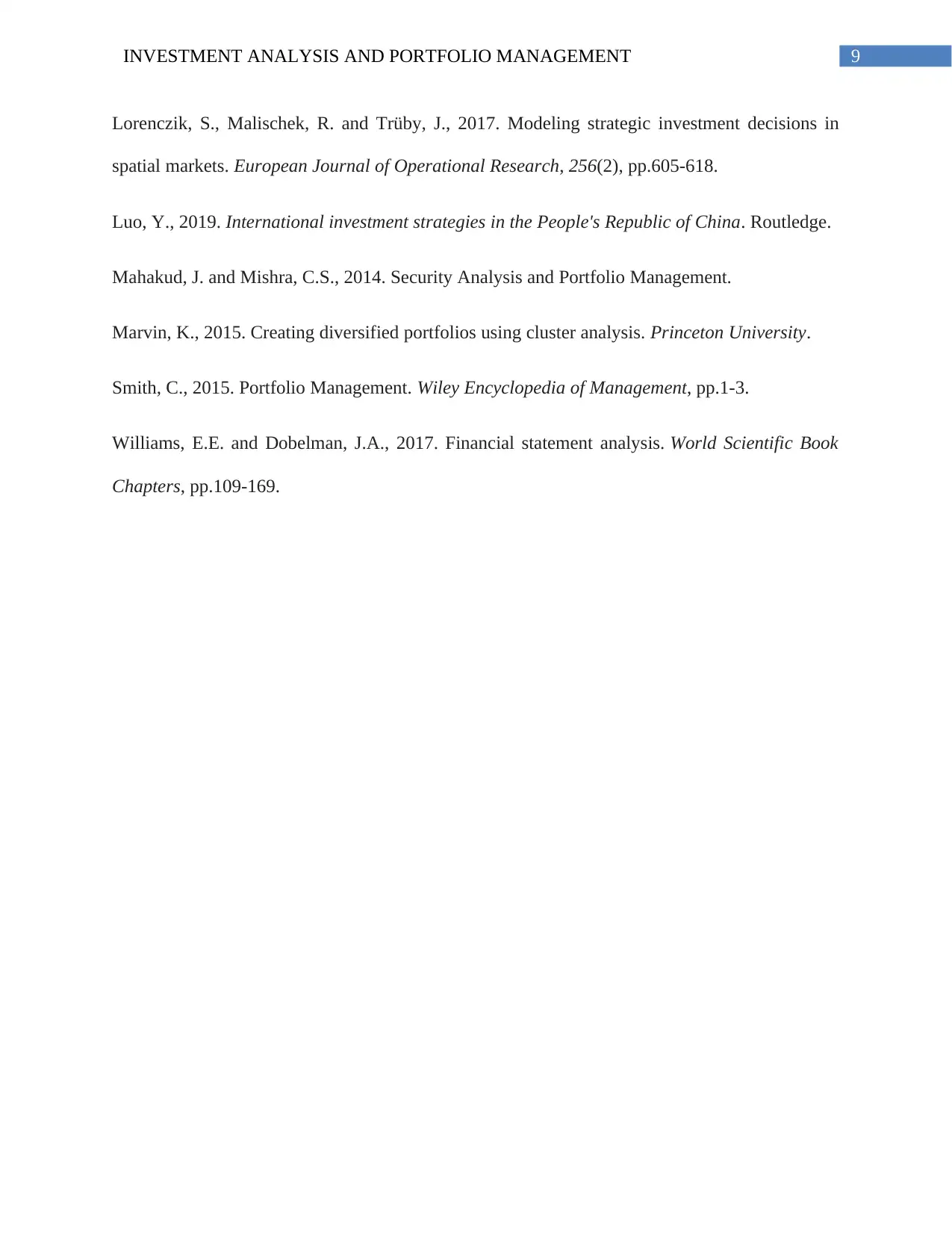
9INVESTMENT ANALYSIS AND PORTFOLIO MANAGEMENT
Lorenczik, S., Malischek, R. and Trüby, J., 2017. Modeling strategic investment decisions in
spatial markets. European Journal of Operational Research, 256(2), pp.605-618.
Luo, Y., 2019. International investment strategies in the People's Republic of China. Routledge.
Mahakud, J. and Mishra, C.S., 2014. Security Analysis and Portfolio Management.
Marvin, K., 2015. Creating diversified portfolios using cluster analysis. Princeton University.
Smith, C., 2015. Portfolio Management. Wiley Encyclopedia of Management, pp.1-3.
Williams, E.E. and Dobelman, J.A., 2017. Financial statement analysis. World Scientific Book
Chapters, pp.109-169.
Lorenczik, S., Malischek, R. and Trüby, J., 2017. Modeling strategic investment decisions in
spatial markets. European Journal of Operational Research, 256(2), pp.605-618.
Luo, Y., 2019. International investment strategies in the People's Republic of China. Routledge.
Mahakud, J. and Mishra, C.S., 2014. Security Analysis and Portfolio Management.
Marvin, K., 2015. Creating diversified portfolios using cluster analysis. Princeton University.
Smith, C., 2015. Portfolio Management. Wiley Encyclopedia of Management, pp.1-3.
Williams, E.E. and Dobelman, J.A., 2017. Financial statement analysis. World Scientific Book
Chapters, pp.109-169.
1 out of 10
Related Documents
Your All-in-One AI-Powered Toolkit for Academic Success.
+13062052269
info@desklib.com
Available 24*7 on WhatsApp / Email
![[object Object]](/_next/static/media/star-bottom.7253800d.svg)
Unlock your academic potential
Copyright © 2020–2025 A2Z Services. All Rights Reserved. Developed and managed by ZUCOL.




